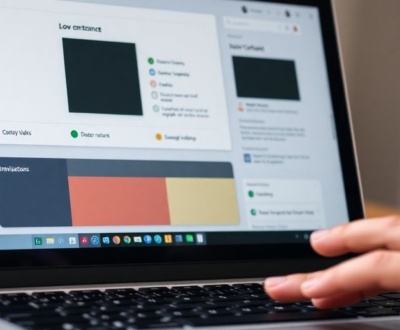Ever landed on a website page that just says “404 Not Found”? It’s pretty annoying, right? For website owners, these error pages can be a real problem, not just for people trying to find stuff, but also for how search engines see your site. But what if you could turn that common frustration into something helpful? This article will walk you through how a good seo friendly 404 page design can actually work for you, making your site better for users and even giving your search engine rankings a little boost.
Key Takeaways
- A well-made 404 page might not directly help SEO, but it makes your site much better for users, which search engines like.
- Your custom 404 page should look and feel like the rest of your site, and it needs to tell people clearly what happened.
- Help users find their way by adding a search bar or links to popular content on your 404 page.
- Make sure your 404 page sends the correct technical signal (a 404 HTTP status code) to search engines.
- Regularly check for and fix any 404 errors on your site using tools like Google Search Console.
Understanding the Impact of 404 Pages on SEO

404 pages. We’ve all seen them. They can be frustrating, but they’re a natural part of the web. But do they really hurt your SEO? The short answer is: it’s complicated. A well-handled 404 page can actually be a good thing, or at least not a bad thing, for your site’s search ranking. Let’s break it down.
The Indirect SEO Benefits of a Custom 404 Page
Okay, so a 404 page itself isn’t going to magically boost your search engine results. However, a customized 404 page can have a positive indirect impact. Think about it: when someone lands on a broken page, they’re likely to bounce. A high bounce rate? Not great for SEO. But a helpful, well-designed 404 page can keep them on your site longer, exploring other content. This improved user experience signals to search engines that your site is user-friendly, which can improve your rankings over time. It’s all about turning a negative into a positive.
Why a Customized 404 Page is Important for User Experience
Imagine this: you click a link, expecting to find awesome information, and BAM! You’re hit with a generic, unhelpful "Page Not Found" error. Frustrating, right? A customized 404 page shows you care. It tells users, "Hey, we know this isn’t what you wanted, but we’re here to help." By providing helpful links, a search bar, or even just a friendly message, you can turn a potential exit into continued engagement. Think of it as a second chance to retain users and guide them to the content they were looking for. A good user experience is always good for SEO, even if it’s indirect.
Distinguishing Between True 404s and Soft 404s
Not all 404s are created equal. There are "true" 404s, which are the standard "Page Not Found" errors. Then there are "soft" 404s. A soft 404 is when a page appears to be working (it loads), but it actually contains very little or no content. Search engines can get confused by these. They might index the page, thinking it’s a real page, even though it’s essentially empty. This can dilute your site’s overall quality and hurt your SEO. It’s important to make sure your server is sending the correct 404 HTTP status code for truly missing pages. This helps search engines understand which pages are actually gone and which ones are still valid.
Essential Elements of an SEO Friendly 404 Page Design
Okay, so you’ve got a 404 page. That’s a start. But is it working for you? A good 404 page isn’t just a dead end; it’s a chance to keep users on your site and maybe even turn a negative into a positive. Let’s talk about the stuff that really matters when designing a 404 page that doesn’t tank your SEO.
Maintaining Brand Consistency on Your 404 Page
Your 404 page should feel like it belongs on your website. I mean, it does belong on your website, so it should look like it! Keep the same design elements, colors, fonts, and overall tone as the rest of your site. This helps users know they’re still in the right place, even if they hit a dead end. It’s jarring to land on a completely different-looking page, and it can make people think they’ve left your site altogether. Think of it as a continuation of your brand experience, even in error. This is important for brand recognition.
Providing Clear and User-Friendly Messaging
Don’t just say "404 Error." Explain what happened in plain language. Something like, "Oops! We couldn’t find the page you were looking for" is a good start. Then, tell them what they can do next. A good 404 error page should be clear and helpful, with a friendly message explaining the page is missing and offering suggestions for navigation. Avoid technical jargon or blaming the user. Keep it simple, friendly, and helpful.
Guiding Users Back to Relevant Content
The whole point of a custom 404 page is to keep people on your site. So, give them options! Don’t just leave them stranded. Here are a few ideas:
- A search bar (we’ll talk more about that later).
- Links to your most popular pages.
- Links to important sections of your site (like your blog, shop, or contact page).
- A link back to the homepage.
The goal is to give users a clear path to find what they were looking for, or something similar. Think about what content might be relevant to someone who landed on the 404 page and provide those links.
A well-designed 404 page turns a potential exit into an opportunity for further engagement. It’s about anticipating user needs and providing solutions, even when things go wrong. It shows you care about the user experience and are willing to help them find what they need. This can significantly improve their perception of your site and brand.
Implementing Effective Navigation on Your 404 Page
So, you’ve got a user staring at a 404 page. Not ideal, but it happens. The trick now is to get them back on track. A well-designed 404 page isn’t just a dead end; it’s a second chance to keep them engaged. Think of it as a helpful nudge in the right direction. Let’s look at some ways to make that happen.
Integrating a Prominent Search Bar
A search bar is probably the single most useful thing you can put on a 404 page. Why? Because it lets users tell you exactly what they were looking for. Don’t hide it; make it big and obvious. A simple "What are you looking for?" prompt can work wonders. It shows you’re trying to help, not just shrugging your shoulders. This is way better than a generic error message. It’s about giving the user control and a way to fix their own problem. Plus, it gives you data on what people are searching for but not finding, which is gold for content planning. Make sure the search bar is functional and returns relevant results.
Offering Links to Popular or Suggested Content
Okay, so maybe they don’t know exactly what they want. That’s where suggested content comes in. Think of it as a curated list of your greatest hits. What are your most popular pages? What content is most relevant to the area they were trying to access? A few well-chosen links can be a lifesaver. Here’s a quick example:
- Top 5 Blog Posts
- Newest Products
- Help Center
It’s all about anticipating their needs and giving them options. This keeps them on your site and reduces bounce rate. Plus, it shows you’re actively trying to help them find something of interest. It’s a win-win.
Directing Users to the Homepage or Main Sections
Sometimes, the best thing you can do is offer a clean slate. A clear, prominent link back to the homepage or main sections of your site can be surprisingly effective. It’s like saying, "Okay, you’re lost. Let’s start over." Make sure the link is easy to find and clearly labeled. Something like "Back to Homepage" or "Browse Our Categories" works great. Don’t make them hunt for it. This is especially important for users who landed on the 404 page from an external link. Give them an easy out and a way to start fresh. It’s about providing a simple, user-friendly experience, even when things go wrong.
A well-designed 404 page should feel like a helpful detour, not a dead end. By providing clear navigation options, you can turn a potentially frustrating experience into a positive interaction and keep users engaged with your site.
Technical Considerations for an SEO Friendly 404 Page Design
It’s easy to focus on the design and messaging of your 404 page, but don’t forget the technical side! Getting this right is important for SEO and making sure search engines understand what’s going on.
Ensuring Proper 404 HTTP Status Codes
Your 404 page needs to send the correct HTTP status code. This tells search engines that the page is actually missing. If you don’t, Google might think the page exists and try to index it, which isn’t what you want. A proper 404 status code helps search engines understand the page is gone and shouldn’t be indexed.
Avoiding Soft 404 Errors for Better Crawling
Soft 404s happen when a page shows a "page not found" message but sends a 200 OK status code. This is bad because search engines think the page is fine, even though it’s not. This can confuse crawlers and waste their time. Make sure your server is configured to send a 404 status code for missing pages to avoid soft 404 errors.
Tracking and Fixing 404 Errors Effectively
It’s not enough to just have a good 404 page; you also need to keep an eye on 404 errors. Here’s how:
- Use Google Search Console to find 404 errors on your site.
- Regularly crawl your website to identify broken links.
- Fix broken links by redirecting them to relevant pages or updating the links.
Ignoring 404 errors can hurt your site’s SEO over time. By tracking and fixing them, you’re showing search engines that you care about your site’s quality and user experience. This can lead to better rankings and more traffic.
Best Practices for User Engagement on 404 Pages
It’s easy to overlook the 404 page, but it’s a real opportunity to keep users engaged even when they hit a dead end. A generic 404 page can be frustrating, leading visitors to abandon your site. Let’s look at some ways to turn that frown upside down.
Showing You Care About User Experience
First and foremost, your 404 page should show that you acknowledge the user’s inconvenience. A simple, friendly message can go a long way in reassuring visitors that you’re aware of the problem and are trying to help. Don’t just leave them hanging with a cryptic error message. Make it clear that the page they were looking for isn’t there, but offer assistance.
Leveraging Creativity and Humor to Improve Brand Perception
This is where you can really shine. A little creativity can transform a negative experience into something memorable. Think about incorporating humor, relevant imagery, or even a mini-game. The goal is to make the 404 page align with your brand’s personality. If your brand is playful, a funny 404 page can be a great way to reinforce that image. If your brand is more serious, a helpful and informative 404 page can demonstrate your commitment to customer service.
Turning a Negative Experience into a Positive Interaction
Ultimately, a well-designed 404 page can turn a potential loss into a win. By providing helpful resources, clear navigation, and a touch of personality, you can encourage users to stay on your site and continue exploring. Think of it as a second chance to make a good impression. Here are a few ideas:
- Offer a search bar to help users find what they’re looking for.
- Provide links to popular or suggested content.
- Include a contact form or email address for users to report the broken link.
A custom 404 page isn’t just about fixing errors; it’s about showing your users that you value their experience and are willing to go the extra mile to help them find what they need. It’s a small detail that can make a big difference in how users perceive your brand.
Common Mistakes to Avoid in 404 Page Design
It’s easy to overlook the 404 page, but a bad one can really hurt your site’s SEO and user experience. Let’s look at some common mistakes people make when designing these pages.
Not Customizing the 404 Page
One of the biggest mistakes is just using the default 404 page that comes with your server or CMS. These generic pages usually don’t offer any help to the user and can make your site look unprofessional. Customization is key. A customized page can keep users engaged.
Failing to Test Your 404 Page Functionality
It’s surprising how many people set up a custom 404 page and then never actually test it. You need to make sure it’s actually displaying when a user tries to access a non-existent page. A broken 404 page is worse than no 404 page at all!
Ignoring Google’s Recommendations for Custom 404s
Google has specific guidelines for creating custom 404 pages. Ignoring these can negatively impact your SEO. For example, you need to make sure the page returns a 404 HTTP status code, not a 200 (OK) or a 301 (redirected). Also, don’t redirect all 404s to your homepage. That’s confusing for users and search engines.
A well-designed 404 page should guide users back to your content, not leave them stranded. Make sure it includes helpful links, a search bar, and clear messaging. It’s a chance to turn a negative experience into a positive one.
Tools and Methods for Identifying 404 Errors

Okay, so you’ve got your custom 404 page all set up, but how do you even find those pesky errors in the first place? It’s not like users are going to email you every time they hit a dead end. Here are some tools and methods to help you sniff out those 404s and keep your site running smoothly.
Utilizing Google Search Console for Error Reports
Google Search Console is your best friend when it comes to understanding how Google sees your site. It provides reports on crawl errors, including 404s, that Googlebot encounters. This is super useful because it tells you about broken links that Google is actively trying to index. To find these reports, log into Search Console, go to the ‘Coverage’ section, and filter for ‘Error’ status. You’ll see a list of URLs that are returning a 404. From there, you can investigate the source of the error and implement a fix, like a redirect or content update.
Employing Website Crawlers Like Screaming Frog
Screaming Frog is a powerful website crawler that can mimic how search engines crawl your site. It’s like having your own little robot that explores every nook and cranny, identifying broken links and other issues. You can configure Screaming Frog to crawl your entire site and report on all 404 errors. This is especially helpful for larger sites where manually checking every link is impossible. Plus, it gives you a ton of other useful SEO data, so it’s a worthwhile investment. Here’s a quick rundown of what you can do with it:
- Find broken internal and external links.
- Analyze page titles and meta descriptions.
- Discover duplicate content.
- Generate XML sitemaps.
Checking Google Analytics for 404 Error Reports
While Search Console shows you errors Google finds, Google Analytics can show you 404s that real users are hitting. This is important because it gives you insight into user behavior and potential usability issues. To set this up, you’ll need to configure Analytics to track 404 page views. This usually involves setting up a custom report or event tracking that looks for the title of your 404 page (e.g., "Page Not Found"). Once you’ve done that, you can see which URLs are generating the most 404s and address them accordingly.
Monitoring 404 errors is an ongoing process. Regularly checking these tools will help you identify and fix issues before they negatively impact user experience or SEO. It’s all about keeping your site clean and user-friendly.
Conclusion
So, that’s pretty much it. A custom 404 page might not be the first thing you think about for SEO, but it really does make a difference for people visiting your site. When someone hits a dead end, a good 404 page can turn that frown upside down, keeping them on your site and maybe even helping them find what they were looking for. It’s all about making things easy for your users, and that’s something Google definitely likes. So, take a little time, make your 404 page helpful and on-brand, and you’ll be in good shape.
Frequently Asked Questions
Does a special 404 page help my site show up better in search results?
A custom 404 page doesn’t directly boost your SEO. However, it helps by making sure fewer people hit a dead end on your site. When visitors have a better experience, they’re more likely to stick around, which can indirectly help your site rank better.
How do I make my own custom 404 page?
There’s no single best way to make a custom 404 page, as it depends on what your website needs. But some good ideas include making sure the page gives helpful info and is easy to use. Also, add links to other parts of your site that visitors might like. You can usually create a custom 404 page by changing a file called ‘404.php’ in your website’s theme.
What are some ways to find 404 errors on my website?
You can find 404 errors in a few ways. First, use Google Search Console; it has reports that show these errors. Second, try a website crawler like Screaming Frog, which checks your site for broken links. Third, if you use Google Analytics, look for the ‘404 Errors’ report under the ‘Behavior’ section.
Should I really make my own 404 pages?
Google suggests making your own 404 pages. If you can get to your server’s setup files, you can make these error pages useful. A good custom 404 page helps people find what they’re looking for and offers other helpful stuff to make them explore your site more.
What are the basic rules for making a custom 404 page?
When you make a 404 page, keep your website’s look and feel the same. This way, users will know they’re still on your site, even if something went wrong. Also, be nice and explain why they landed on that page without using confusing tech words. Lastly, give them links to other useful pages, like your most popular ones or your homepage.
What are some common mistakes people make with 404 pages?
A common mistake is not making your 404 page unique; many sites just have a plain one that isn’t very helpful. Another error is not checking if your 404 page works right or sends people to the correct places. Lastly, ignoring what Google advises for custom 404s can also be a problem.
About this blog
We are a digital marketing company with a focus on helping our customers achieve great results across several key areas.
Request a free quote
We offer professional SEO services that help websites increase their organic search score drastically in order to compete for the highest rankings even when it comes to highly competitive keywords.









